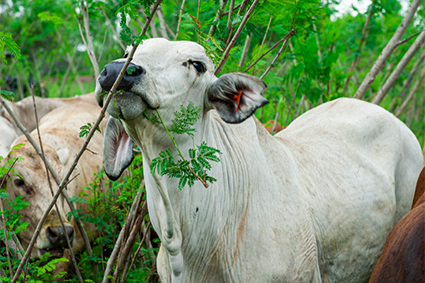Leucaena
The most productive and sustainable legume-grass pasture for northern Australia is leucaena. It can double productivity and profitability, compared with the performance of improved grass pasture alone.
Featured resources

An introduction to Leucaena – the productive and sustainable forage legume
An introduction to establishing, managing and grazing leucaena, considering intensification and maximising live weight gains.

Producer case study: Brett and Theresa Blennerhasset
North Queensland beef producers Brett and Theresa Blennerhasset’s measured approach to managing leucaena is paying dividends.
Steers on grass without supplements typically gain 140–190kg/ year because the grass protein content is too low. In contrast, steers grazing leucaena will on average gain 250–300kg/year – without supplements – and at higher stocking rates.
Typical performance by steers grazing a range of pasture systems in tropical Queensland (modified after DPI&F).
| Forage system | Average stocking rate (ha/steer) | Liveweight (kg/steer) | gain/year |
|---|---|---|---|
|
Native pasture - central Qld |
10 |
100-140 |
25-35 |
|
Buffel grass - run down |
3 |
140-150 |
45-50 |
|
Buffel grass - good condition |
2 |
170-190 |
85-95 |
|
Leucaena - buffel grass |
1.5 |
250-300 |
165-200 |
Leucaena delivers a number of productivity, welfare and environmental benefits but it is not suited to all areas, soil types or production systems.
Benefits of leucaena
Leucaena delivers great benefits where the environment and the production system are suitable. Benefits include:
- Sustainability - Planting leucaena offers the opportunity to sustainably intensify production on the best land. This frees other areas for conservation and protection from over-grazing.
- Longevity and cost reductions – a potential 30+ year productive life span makes leucaena more profitable than any other improved pasture. Despite its higher establishment cost, it replaces the need for annual forage crops.

- Drought proofing - leucaena is a deep-rooted perennial shrub legume. It keeps producing high-quality green leaf through the drier periods of summer, autumn and early winter.
- Improved soil fertility - nitrogen fixed by leucaena improves grass quality and quantity. It reverses the ‘nitrogen run-down’ seen in pure-grass swards.
- Better weight gains for longer - leucaena is the most productive and sustainable tropical forage legume. No other forage plant can put the same weight on stock over so long a period of the year.
- Top nutritional value - leucaena leaf is high in protein and is easily digested by ruminants.
- High palatability - cattle prefer leucaena to most other forages. This leads to high intake and subsequent weight gains.
- Market flexibility - excellent weight gains allow targeting of markets when prices are highest.
- Reduced soil erosion - planting leucaena and a vigorous grass across slopes encourages water infiltration and reduces run off.
- Prevention of rising water tables and salinity - leucaena's deep roots can extract water from the soil to a depth of 3-5m. This prevents rising water tables that can bring salt to the soil surface.
- Greenhouse gas reduction - Carbon is sequestered in the woody growth. Highly digestible leucaena diets can reduce cattle methane production by 20-30%.
Limitations of leucaena
Leucaena is not for everyone and before you start planting it is important to consider the following:
- Geography – leucaena is not suitable for the whole of northern Australia.

- Soil type – it grows best on deep fertile soils with more than 600 mm rainfall.
- Cost to establish - establishment can be slow and costly as leucaena seedlings suffer strongly from weed competition. Potential attack by insects, kangaroos, wallabies and hares is also a threat. Depending on the conditions it may take up to two years to establish fully during which time it can only be lightly grazed.
- Frost – its green leaf and stem can be frosted to ground level, but the plant will recover.
- Psyllids – these insects can damage older cultivars in humid environments with rainfall above 800 mm. The new Redlands variety of leucaena addresses this by being psyllid-resistant.
- Toxicity – leucaena can be toxic if the animals are not inoculated with special rumen bacteria. Unadapted animals can also experience short-term leucaena toxicity if they are not introduced gradually to leucaena.
- Environmental concerns – heavy seed production can occur without good management. Tall growth must be controlled by appropriate grazing or mechanical slashing.
Publications and resources
- Leucaena - the productive and sustainable forage legume: download the complete manual (4MB)
Download by chapter:
Other resources
- An introduction to leucaena – the productive and sustainable forage
- Tips & Tools: Using leucaena in the Darling Downs
- Top tips to growing leucaena
Case Studies
- Leucaena for the long-run - Brett Blennerhasset, Goshen Station, Central Queensland
- Feed that keeps on giving - Stephen and Christine Williams, Darling Downs, Queensland


